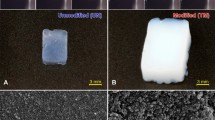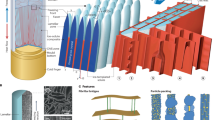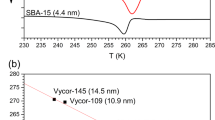Abstract
Phase separation during directional freezing of liquid systems leads to a variety of microstructures of the components due to the interplay of heat transfer, diffusion kinetics, and interfacial surface energy1–6. One of the more dramatic effects is the in situ formation of parallel fibres in directionally solidified eutectic superalloy. We report here similar morphological consequences of freezing aqueous polysilicic acid. This system is unique not only because it has an amorphous component, polysilicic acid, but this substance undergoes accelerated, concentration-dependent polymerization immediately after phase separation. As a result, it becomes insoluble, and after thawing, preserves the structure that had been conferred on it by the surrounding ice. We have explored the relationships of polymerization, composition, and freezing conditions with the morphology of the products, in particular with regard to fibre formation.
This is a preview of subscription content, access via your institution
Access options
Subscribe to this journal
Receive 51 print issues and online access
$199.00 per year
only $3.90 per issue
Buy this article
- Purchase on Springer Link
- Instant access to full article PDF
Prices may be subject to local taxes which are calculated during checkout
Similar content being viewed by others
References
Tiller, W. A., Jackson, K. A., Rutter, J. W. & Chalmers, B. Acta metall. 1, 428–437 (1953).
Tiller, W. A. in The Art and Science of Growing Crystals (ed. Oilman, J. J.) 276–312 (Wiley, New York, 1963).
Mullins, W. W. & Sekerka, R. F. J. appl. Phys. 34, 323–329 (1963).
Kraft, R. W. J. Metals, N.Y. 18, 192–200 (1966).
Hunt, J. D. & Jackson, K. A. Trans metall. Soc. AIME 236, 843–852 (1966).
Double, D. D. Krist. Technol. 9, 569–586 (1974).
Bird, P. G. US Patent 2,244,325 (1941).
Mahler, W. US Patent 4,122,041 (1978).
Carslaw, H. S. & Jaeger, J. C. Conduction of Heat in Solids 282–293 (Clarendon, Oxford, 1959).
Hazel, J. F. & Schipper, E. J. Colloid Sci. 5, 532–540 (1950).
Kolosentsev, S. D., Belotserkovskii, G. M. & Plachenov, T. G. J. appl. Chem. USSR 48, 253–254 (1975).
Lottermoser, A. Chem. Ber. 41, 3976–3979 (1908).
Kautsky, H. & Irnich, R. Z. anorg. allg. Chem. 295, 192–217 (1958).
Hinz, W., Ruttloff, H. & Täufel, A. Silikattechnik 10, 378–381 (1962).
Halberstadt, E. S., Henisch, H. K., Nickl, J. & White, E. W. J. Colloid Interface Sci. 29, 469–471 (1969).
Schorger, A. W. US Patent 1,949,360 (1934).
Vol'khin, V. V., Ponomarev, E. I. & Zolotavin, V. L. Inorg. Mater. USSR 1, 1435–1438 (1965).
Author information
Authors and Affiliations
Rights and permissions
About this article
Cite this article
Mahler, W., Bechtold, M. Freeze-formed silica fibres. Nature 285, 27–28 (1980). https://doi.org/10.1038/285027a0
Received:
Accepted:
Issue Date:
DOI: https://doi.org/10.1038/285027a0
This article is cited by
-
Critical impact of nanocellulose on the synthesis of porous cellulose monolith with oriented microchannels: Structure control, mechanics, and mass transport
Nano Research (2023)
-
Aerogels based on carbon nanomaterials
Journal of Materials Science (2016)
-
Hierarchically porous materials: Synthesis strategies and emerging applications
Frontiers of Chemical Science and Engineering (2016)
-
Self-assembly of hollow PNIPAM microgels to form discontinuously hollow fibers
Chinese Journal of Polymer Science (2014)
-
Porous microfibers and microhoneycombs synthesized by ice templating
Catalysis Surveys from Asia (2006)
Comments
By submitting a comment you agree to abide by our Terms and Community Guidelines. If you find something abusive or that does not comply with our terms or guidelines please flag it as inappropriate.



